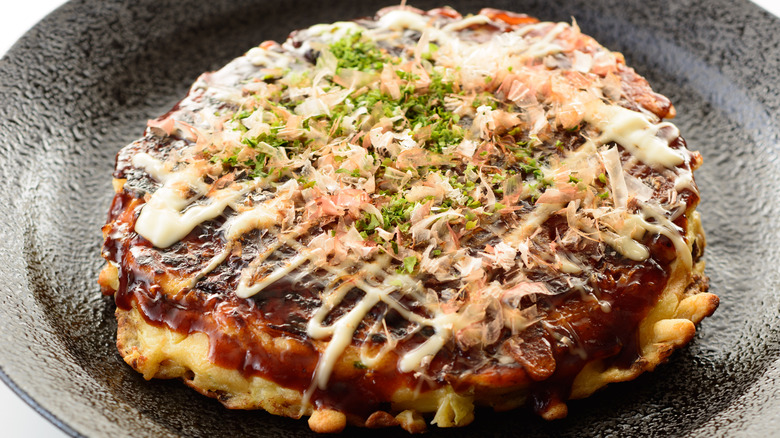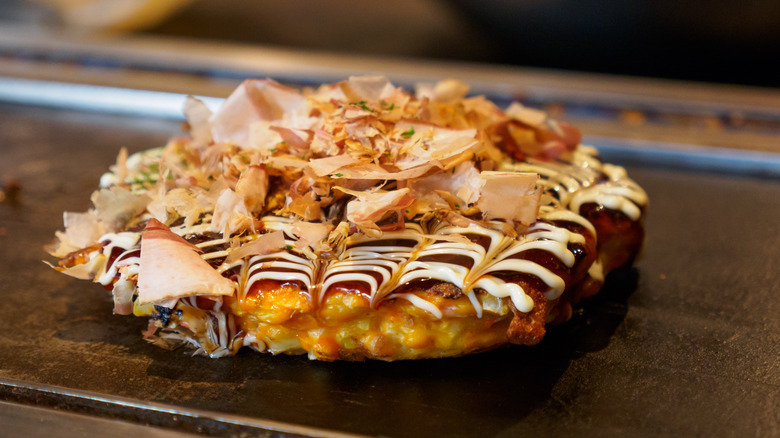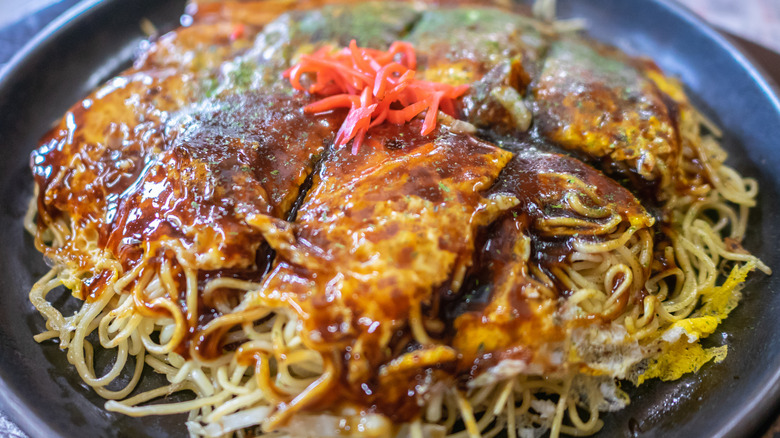Osaka Vs. Hiroshima Okonomiyaki: What's The Difference?
While it is one of the most important Japanese dishes, Okonomiyaki simply translates to "what you want, grilled." And that is what it seems like when you first encounter it: The fragile pancake is made from a mix of thinly sliced pork, eggs, flour, and cabbage. Okonomiyaki is based on a much older dish, a sweet crepe eaten during Buddhist ceremonies called funoyaki. Funoyaki spread outside of the Buddhist monasteries and became sukesoyaki before finally being named okonomiyaki in the 1930s in Osaka, Japan.
It's hard to compare this dish to any other pancake since it is so very loosely a pancake, and the minimal batter merely clings to the cabbage to keep it in its circular shape. It can be said that the Osaka okonomiyaki is the original version since that's where it got its name. Eventually, the "whatever you want" dish did indeed become whatever one wanted, especially during and after World War II. Rice scarcity made the dish more popular than ever, although it omitted some of the more precious additions like egg and pork. The dominant versions that remain today are the Osaka and Hiroshima okonomiyaki, which have some key similarities but are very different from one another.
Osaka okonomiyaki: The original okonomiyaki
Osaka okonomiyaki is the easier dish to prepare of the two varieties since it comes together in one bowl. Cabbage is a crucial ingredient in all okonomiyaki preparations, and it's usually thinly sliced or chopped so that it wilts easily once grilled. You add a thin batter mixture made from flour, water, eggs, and dashi stock over the cabbage and sliced green onions and mix them until roughly homogenous. Then, you ladle this cabbage pancake onto a frying pan. The batter holds its shape very well, so you'll have a cohesive cabbage pancake. While the first side of the pancake is cooking and solidifying, you are welcome to add thin slices of pork on the second side so that it clings to the raw batter. Afterward, a quick flip and a few minutes on the second side should give you a finished pancake.
The sauces are also very crucial to the overall okonomiyaki experience: You need a strong drizzle of eel sauce, which is intensely sweet and salty, as well as Japanese mayonnaise. Many restaurants serve okonomiyaki with a gorgeous criss-cross pattern with these condiments. You can then add your toppings of choice, which are usually bonito flakes, aonori (dried seaweed), and pickled ginger. The finished result is a thick pancake you can cut through, or even just have a slice of. The salty and creamy condiments are a flavor bomb on the otherwise neutral cabbage, pork, and batter.
Hiroshima okonomiyaki: A dish of resilience
In Hiroshima, there was a thin crepe-like pancake called issen yōshoku, which means "Western food for a penny." This cheap dish combined with okonomiyaki was the foundation of the Hiroshima okonomiyaki as we know it. Much of the structure and additions to this dish can also be attributed to World War II. After the catastrophic bombing of Hiroshima in 1945, its people had to eat what was readily available to them, which meant cooking with noodles instead of rice.
The pancake is a thin crepe made from a simple batter that is topped on the stove with a mountain of cabbage. After you add the cabbage, along with other vegetables like spring onions and bean sprouts, you drizzle on a bit of batter to hold it together. When the pancake is semi-cooked, thin slices of pork are added on top of the heap of cabbage. Once the side with the pork becomes sufficiently browned, you can set the whole thing aside and stir-fry egg noodles in the shape of a pancake. Then, the pancake is placed on top of the noodles, and a fried egg finishes the entire dish.
Flipping a Hiroshima okonomiyaki can be a daunting task, and it takes lots of practice to keep it in one piece. It's served with the same condiments and bonito flake topping, but this dish is much more filling than the Osaka version.


